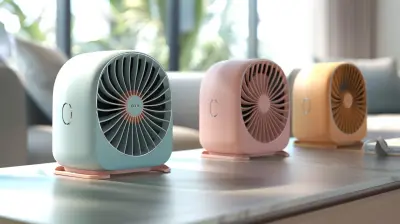How Wearables are Pushing the Boundaries of Sustainable Health Tech
30 September 2025
When you think of tech and sustainability, your mind might leap to electric cars or solar panels. But guess what? Some of the most exciting innovations are happening right on your wrist—or around it. Yep, we’re talking about wearables. Those sleek smartwatches, fitness trackers, smart rings, and even connected clothing are doing more than just counting your steps. They’re revolutionizing how we engage with our health, while quietly driving the movement for sustainable healthcare.
In this guide, we’ll get into the nitty-gritty of how wearables are transforming healthcare and giving sustainability a much-needed tech-powered boost.
The Rise of Wearable Health Tech
Let’s rewind for a second. Not too long ago, if you wanted to monitor your heart rate or blood pressure, you’d have to visit a clinic. Now? Your smartwatch does it on-the-fly while you sip your morning coffee.Wearables have evolved big time. They’ve gone from fitness accessories to essential health tools. We're talking about devices that can:
- Track vital signs (heart rate, oxygen saturation, sleep patterns)
- Detect early symptoms (like irregular heart rhythms)
- Encourage healthier lifestyles through data-driven nudges
- Reduce avoidable hospital visits
Sound impressive? That’s just scratching the surface.
What Makes Health Wearables Sustainable?
Okay, sustainability might not be the first thing you associate with a smart ring, but it should be. Here's why:1. Preventive Healthcare Equals Fewer Resources Used
Traditional medicine is often reactive. You feel sick, you go to the doctor, you get tests, treatments, prescriptions—the whole nine yards. That means energy, materials, time, and money.Wearables flip that model on its head. By constantly collecting health data, they help detect issues before they snowball. Less emergency care, fewer medications, fewer hospital stays. From a sustainability angle, this is huge. It’s like putting smoke detectors in every room instead of waiting for the house to catch fire.
2. Remote Monitoring Saves Big on Carbon
Think about all the travel involved in healthcare. Multiple appointments, especially for chronic conditions or post-op follow-ups, can mean a lot of back-and-forth trips. That’s a lot of fuel and emissions.Wearables enable remote health monitoring. Doctors get live updates, patients stay home, and the planet breathes easier. It's a win-win.
3. Data-Driven Efficiency
Data is the new oil, but it’s also the fuel for smarter healthcare decisions. By aggregating and analyzing data from wearables, healthcare systems can better allocate resources—targeted outreach, personalized treatments, and focused public health campaigns. No more one-size-fits-all. Efficiency means sustainability, plain and simple.
Materials Matter: Greener Devices Are On the Way
Now, let’s talk about the elephant in the room: the gadget itself. Tech devices can be resource-hungry to manufacture. But good news—tech companies are catching on. More and more wearable producers are leaning into eco-friendly materials and ethical manufacturing practices.Here’s how they’re stepping up:
🌱 Eco-Friendly Materials
Some wearables are incorporating recycled plastics, biodegradable bands, and even plant-based polymers. Apple, for instance, has moved towards using recycled aluminum in some of their products, and they're not alone.🔋 Power Efficiency
Battery tech is seeing green upgrades too. Devices are being designed to use less energy and charge faster. Some experimental wearables even use body heat or solar to stay powered—talk about futuristic!🔁 Modular Designs for Easy Repair and Recycling
Instead of tossing out your device when one part breaks, imagine just swapping out that component. These modular designs reduce e-waste and extend product life cycles. It’s like giving wearables a second (or third) life.
Wearables, Big Data, and Environmental Health
We usually think of wearables as individual health tools, right? But when millions of people use them, that data becomes a goldmine for public health and even environmental monitoring.Here’s what’s happening:
- Aggregated data helps detect health trends triggered by environmental changes (like poor air quality leading to asthma spikes)
- Combined data can guide urban planning to promote healthier, more active cities
- Climate-related health risks (heatwaves, pollen, etc.) can be tracked in real-time to warn vulnerable populations
It’s a smart way to combine personal wellness with planetary well-being.
Cutting Down Healthcare Waste
Healthcare is one of the top contributors to environmental waste. Think of all the single-use instruments, hospital emissions, and pharmaceutical runoff.By promoting preventive care and minimizing unnecessary diagnostics, wearables can help reduce this waste. That’s less pressure on hospitals, fewer lab tests, and ultimately, a smaller carbon footprint for the healthcare system overall.
Equitable Access & The Digital Health Divide
We’re not gonna sugarcoat it—there’s still a gap when it comes to access. Not everyone can afford the latest smartwatch that tracks blood oxygen levels or sleep stages. But the good news? That’s changing.Tech companies and health organizations are working on:
- Lower-cost wearables for underserved communities
- Insurance incentives or subsidies for wearable devices
- Partnerships with public health systems to expand access
The more inclusive wearable tech becomes, the more sustainable and equitable our entire health system gets. Because what’s the point of a revolution if it leaves people behind?
Real-World Use Cases: Wearables in Action
Let’s put a face to all this tech talk. Here are a few real-world examples where wearables are making waves:🏥 Chronic Disease Management
Patients with diabetes can now monitor glucose levels 24/7 with non-invasive wearables. That means fewer needle pricks, fewer hospital visits, and better overall control.🧠 Mental Health Support
Wearables can track heart rate variability and stress markers to detect signs of anxiety or depression. Some pair with mindfulness apps to nudge you toward better mental health routines.👵 Elderly Care
Smartwatches and pendants can detect falls and irregular heartbeats—and automatically alert caregivers or medical personnel. That’s peace of mind and potentially life-saving intervention without any hassle.Challenges Ahead (And How We Might Overcome Them)
Of course, it’s not all sunshine and rainbows. Wearable health tech still has some hurdles to jump:🔒 Privacy Concerns
All that data? Super helpful, but also super sensitive. It’s gotta be protected.🤔 Accuracy & Reliability
Not all devices are created equal. Some cheaper wearables can misread data, leading to confusion or unnecessary panic.🌍 E-Waste Management
Even the greenest device will eventually stop working. Responsible recycling and proper disposal remain key issues.But guess what? These challenges aren’t dealbreakers—they’re opportunities. Opportunities to build trust, improve tech, and push toward even greener solutions.
The Future of Sustainable Health Tech Looks Bright
It’s clear that wearables are no longer just cool gadgets; they’re becoming the new frontline in healthcare—and sustainability is right there alongside them. These nifty devices can keep us healthier, smarter, and more aware of how our choices affect the planet.As the technology matures, expect to see more integration with AI, better biometric tracking, and even smarter power sources. You might eventually wear a device that not only protects your health but actively helps reduce your carbon footprint. How wild is that?
So, the next time you strap on your fitness tracker or glance at your smartwatch, remember—you’re not just taking a step toward better health. You’re part of a much larger movement: one that’s reshaping healthcare and making it better for everyone, including Mother Earth.
all images in this post were generated using AI tools
Category:
Green TechnologyAuthor:

Michael Robinson
Discussion
rate this article
1 comments
Layne Lawrence
Embrace wearables—game-changers in sustainable health tech. Innovation is the future, don’t resist!
October 4, 2025 at 11:35 AM

Michael Robinson
Absolutely! Wearables are revolutionizing health tech by promoting sustainability and innovation. Embracing this technology can lead to a healthier future for all.


